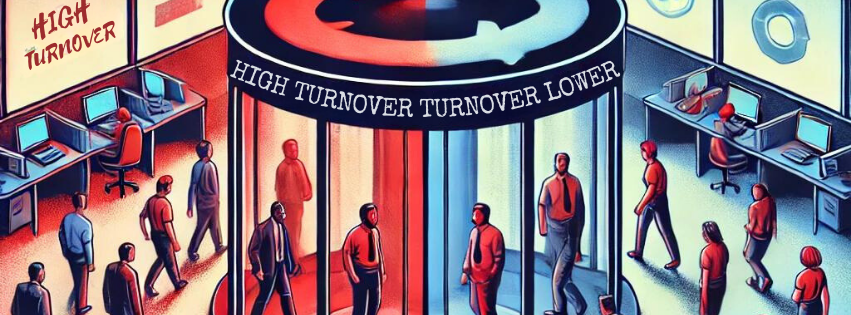If you’ve ever felt the sting of losing a valuable tech team member, you’re not alone. The tech industry is notorious for high turnover rates, and this revolving door of talent doesn’t just hurt productivity—it hits your bottom line, too. In fact, it can cost 30-50% of a developer’s annual salary to replace them when you factor in recruitment, onboarding, training and lost time.
But turnover isn’t just a financial drain; it’s a massive productivity killer.
Projects slow down, deadlines get pushed and team morale takes a hit.
So how do you stop the revolving door?
By understanding the root causes of turnover and implementing proactive strategies to retain your top talent.

At TechTeems, we specialize in helping organizations identify, retain and integrate the right tech talent to stop turnover before it starts. We specialize in helping companies find, screen and integrate tech talent that fits both technically and culturally.
Whether you’re building your team with onshore, nearshore or offshore hires, our process is designed to help you reduce turnover and increase job satisfaction.
Let’s explore why turnover happens and, more importantly, how you can reduce it—using both time-tested strategies and our proven recruitment process.

Why turnover happens: The root of the problem
Before you can fix a problem, you need to understand what’s causing it. In the tech industry, turnover is often driven by a few key factors.
1. Misalignment of roles and expectations
One of the biggest reasons tech professionals leave their jobs is that the role they were hired for doesn’t match their expectations. Maybe the job was oversold, or the scope shifted after they joined.
Either way, misaligned expectations lead to frustration and a feeling that they’re not being utilized to their full potential.
This misalignment can also happen when employees feel like they’re stuck in a role that doesn’t challenge them or allow for growth.
Developers, data scientists and engineers want to solve complex problems and innovate. When they’re pigeonholed into a role that doesn’t allow that, they’re likely to seek opportunities elsewhere.
“The biggest cause of failure in any organization is misalignment between what people are hired to do and what they are expected to do.” — Patrick Lencioni

2. Lack of development opportunities
Staying stagnant isn’t an option for tech professionals. Continuous learning and development are crucial for those who want to keep their skills sharp and stay ahead of industry trends.
Companies that fail to provide these opportunities risk losing their top talent to competitors who do.
Tech professionals value growth. If they feel like their career trajectory is plateauing, it won’t be long before they look for greener pastures.
3. Burnout
It’s no secret that tech roles often come with long hours, tight deadlines and high expectations. This pressure can quickly lead to burnout, especially in startup environments or fast-growing companies.
Burned-out employees are disengaged, less productive and more likely to quit. In fact, burnout is one of the leading causes of turnover in tech.


4. Cultural mismatch
Beyond the technical skills, culture matters—especially in the tech world.
Hiring someone who can code is one thing, but finding a candidate who aligns with your company’s values, vision and work style is critical.
A poor cultural fit can lead to dissatisfaction, communication breakdowns and, ultimately, early exits.
Proven strategies to retain tech talent
So, now that we know what’s driving turnover, let’s dive into the solutions. These strategies have been proven to reduce turnover, increase job satisfaction and ultimately create a more stable, productive workforce.
1. Set clear role expectations from day one
The first step to reducing turnover happens before a new hire even steps through the door. Clear and honest communication during the hiring process is key to ensuring that candidates fully understand the role they’re stepping into. Overpromising on growth opportunities, flexibility or responsibilities may get someone in the door, but it will only lead to dissatisfaction down the line when the reality doesn’t match the pitch.
By being transparent about expectations, workloads and long-term goals during the interview process, you can avoid misalignment and ensure that new hires know exactly what they’re signing up for.
Additionally, set your tech employees up for success with clear KPIs and performance metrics. When employees understand how their work is being measured and what’s expected of them, they’re more likely to feel confident and engaged in their roles.
2. Invest in continuous learning and development
If you want to retain your top tech talent, you need to offer opportunities for professional growth and skill development. This could come in the form of in-house training, certifications, online courses or even offering employees a budget for attending conferences and workshops.
By investing in your team’s learning, you not only increase their value to your company but also show them that you’re committed to their growth. This builds loyalty and reduces the chances that they’ll leave for another job that offers more learning opportunities.
Pro tip: Consider pairing junior employees with senior mentors to create an internal support system and a pathway for ongoing skill development.
Psst! At TechTeems, we don’t just find candidates—we look for long-term fits who are eager to learn and grow with your company. Our focus on finding high-relevance, high-output candidates means we’re connecting you with tech professionals who are not only skilled but driven to advance their careers.
3. Hire for cultural fit
Skills are teachable, but culture fit is something that must be carefully considered during the hiring process. A developer might have all the technical know-how you’re looking for, but if their work style or values clash with your company’s culture, it’s a recipe for turnover.
During interviews, assess not just technical abilities but also how candidates align with your company’s mission, vision and team dynamics. Use behavioral interview questions to understand how they handle feedback, teamwork and problem-solving in real-world scenarios. A strong cultural fit leads to higher job satisfaction and long-term retention.
4. Prioritize work-life balance to prevent burnout
Burnout is a major driver of tech turnover, but it’s also one of the most preventable issues. Companies that prioritize work-life balance are more likely to retain their top talent.
This doesn’t mean just offering the occasional day off—it means actively fostering an environment where employees feel comfortable taking breaks, logging off at a reasonable hour and setting boundaries. Encourage your team to use their vacation time and offer flexible work arrangements to help them manage personal responsibilities alongside their work.
Another way to prevent burnout is by managing workloads effectively. Make sure that projects are adequately staffed, and avoid asking employees to work nights or weekends to meet unrealistic deadlines. Tech professionals thrive in environments where they can tackle challenges without sacrificing their well-being.
5. Recognize and reward contributions
People want to feel valued. When employees know their work is being recognized and appreciated, they’re more likely to stay engaged and loyal to your company. Whether it’s through bonuses, promotions, public recognition or just a simple thank you, acknowledging your team’s contributions goes a long way in retaining talent.

Make it a habit to celebrate achievements—big and small. This could be as formal as a quarterly awards ceremony or as informal as a shout-out in the company Slack channel. The key is consistency and sincerity.
Flexibility and remote work as retention tools
One of the lessons learned from the recent shift towards remote work is that flexibility is a powerful tool for retaining tech talent. Many developers, engineers and designers have adapted to working from home, and they value the freedom and autonomy it provides.
Offering remote work options or hybrid schedules is a great way to keep employees satisfied and reduce the temptation to jump ship for a more flexible job.
Additionally, offering flexible work hours that allow employees to structure their day in a way that suits their productivity rhythms can lead to happier, more engaged employees who are less likely to leave.






Take these steps now to reduce turnover
Turnover isn’t inevitable—it’s a problem that can be managed and mitigated with the right strategies. Start by setting clear role expectations, investing in continuous learning, hiring for cultural fit and prioritizing work-life balance. Recognize your team’s hard work and consider offering flexibility where possible.
By focusing on these areas, you’ll create an environment where your tech professionals want to stay, grow, and contribute long-term.
We can help you build teams that work by making sure you have the right number of resources to meet your deadlines without burning out your staff. Whether you need to hire onshore, nearshore or offshore, we find the tech talent that complements your existing team and spreads out the workload.


